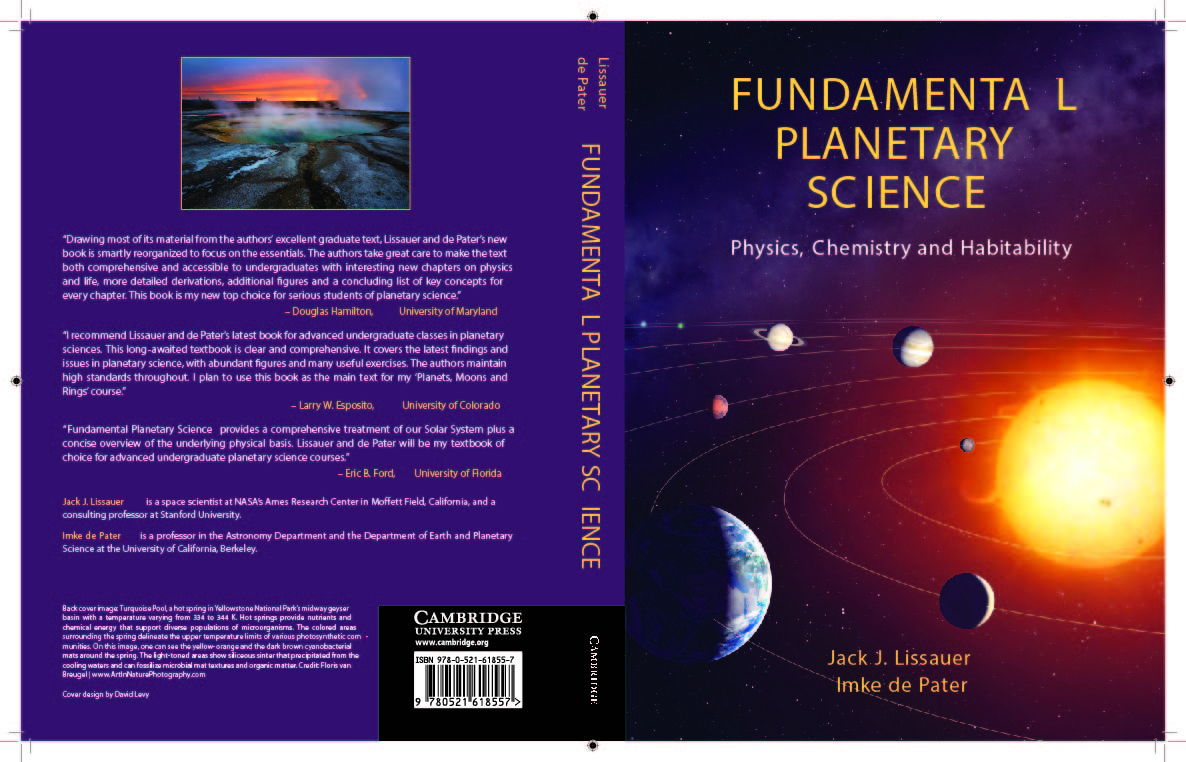
FUNDAMENTAL PLANETARY SCIENCE
Physics, Chemistry and Habitability (September 2013)
Updated Edition (2019)
Jack J. Lissauer and Imke de Pater
[Cambridge: ISBN-13: 9780521618557 Paperback &dollars;60.00 / $80.00]

FUNDAMENTAL PLANETARY SCIENCE
Physics, Chemistry and Habitability (September 2013)
Updated Edition (2019)
Jack J. Lissauer and Imke de Pater
[Cambridge: ISBN-13: 9780521618557 Paperback &dollars;60.00 / $80.00]
The space age with lunar missions and interplanetary probes, has revolutionized our understanding of the Solar System. Planets and large moons, which previously appeared in telescopes only as fuzzy disks, have become familiar worlds, with a range of diverse properties. Large numbers of asteroids, comets and small moons have now been discovered, and many of these objects studied in detail. The number of planets now known to orbit stars other than our Sun far exceeds those within our own Solar System. As a result, our understanding of the process of star and planet formation is increasing all the time.
Fundamental Planetary Science presents a quantitative introduction to the Solar System and planetary systems science for advanced undergraduate students. This engaging new textbook explains the wide variety of physical, chemical, and geological processes that govern the motions and properties of planets. The authors provide an overview of our current knowledge and discuss some of the unanswered questions at the forefront of research in planetary science and astrobiology today. They combine knowledge of the Solar System and the properties of extrasolar planets with astrophysical observations of ongoing star and planet formation, offering a comprehensive model for understanding the origin of planetary systems. The book concludes with an introduction to the fundamental properties of living organisms and the relationship that life has to its host planet. With more than 200 exercises to help students learn how to apply the concepts covered, this textbook is ideal for a one-semester or two-quarter course for undergraduate students.
Chambliss Astronomical Writing
Award:
The authors' first book, Planetary Sciences, received the Chambliss Astronomical Writing
Award for 2007. This is an award given by the American Astronomical
Society (AAS) for astronomy books for an academic audience,
specifically textbooks at either the upper division undergraduate
level or the graduate level.
FRONT COVER:
Design by David Levy
BACK COVER:
Image: Turquoise Pool, a hot spring in Yellowstone National Park's
midway geyser basin with a temperature varying from 334 tp 344 K. Hot
springs provide nutrients and chemical energy that suppport diverse
populations of microorganisms. The colored areas surrounding the
spring delineate the upper temperature limits of various
photosyntheitc communities. On this image, one can see the
yellow-orange and the dark-brown cyanobacterial mats around the
spring. The light-toned areas show siliceous sinter that precipitated
from the cooling waters and can fossilize microbial mat textures and
organic matter. Credit: Floris van Breugel, www.ArtInNaturePhotography.com